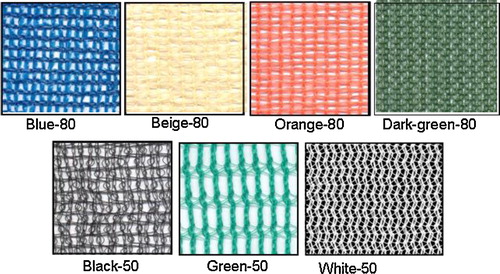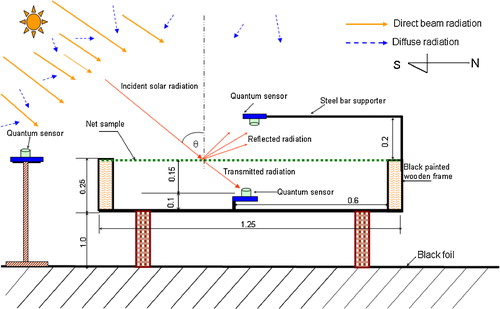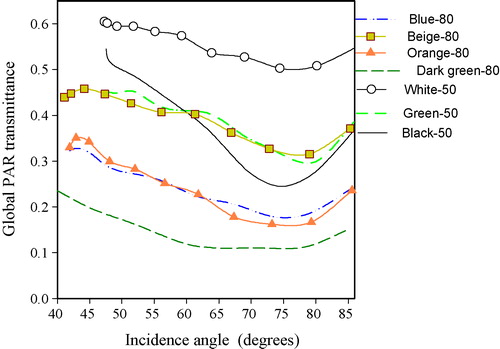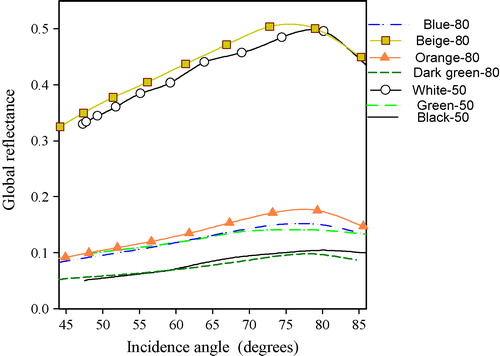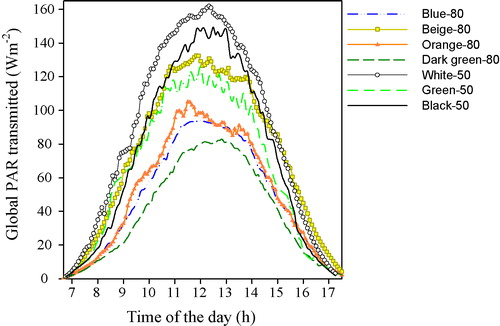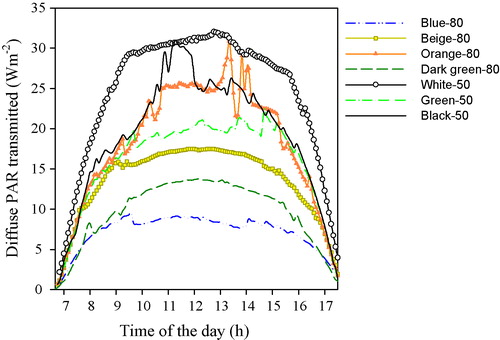 ?Mathematical formulae have been encoded as MathML and are displayed in this HTML version using MathJax in order to improve their display. Uncheck the box to turn MathJax off. This feature requires Javascript. Click on a formula to zoom.
?Mathematical formulae have been encoded as MathML and are displayed in this HTML version using MathJax in order to improve their display. Uncheck the box to turn MathJax off. This feature requires Javascript. Click on a formula to zoom.Abstract
To cover agricultural structures for protecting plants from high solar radiation in hot and sunny regions different types of shading nets are used. In summer, the amount of photosynthetically active radiation (PAR) transmitted through these nets usually fulfils plant growth requirements. However, their applicability in winter is still unknown. So far, the choice of nets has mostly been empirical, because technical data such as the radiometric properties that are used to characterize the different types of nets are not available. This paper presents a simple method for measuring the radiometric properties related to global and diffuse PAR of seven types of shading nets including nets with colours and shading rates that are commonly used in hot regions. A shading system was developed to simulate the diffuse PAR under cloudy conditions. The results show that under clear sunny and cloudy conditions the radiometric properties depended on both net porosity and colour. Net reflectance strongly depended on net colour. Net transmittance and absorptance depended primarily on colour and secondarily on porosity. The radiometric properties of nets under global and diffuse PAR conditions tended to be similar to those of translucent materials so that a plastic net can be considered as translucent material when investigating the equivalent optical parameters (refractive index and absorption coefficient). This can help to predict the radiometric properties of the net without the need of measurements. Under the sunny conditions of winter seasons, the structures covered with the tested nets are suitable for growing crops that can grow at PAR less than 150 W m−2. However, under cloudy conditions very few plants will grow that can grow at PAR less than 30 W m−2.
1 Introduction
Plastic nets in the form of covering materials are widely used for different purposes in the agricultural sector. For example, they are used to protect crops from hail, strong wind, snow, heavy rainfall, insects, animals and birds [Citation1]. Recently, structures covered with plastic nets have become more popular in hot and sunny regions like Saudi Arabia to protect crops from high solar radiation levels in summer. Such structures derive their popularity mainly from consumer demand for growing crops at significantly lower costs compared with growing crops in a conventional greenhouse. Plastic net coverings offer many advantages and environmental benefits [Citation1–Citation4]. In particular, net covering can enhance productivity, quality and homogeneity of plants and fruits throughout the year in hot and sunny regions.
In spite of their popularity, the different coloured types of plastic nets available in the market present horticulturists and engineers with several design problems. In addition, neither consumers nor producers have a clear idea about how to select a plastic net type for a specific application. This is largely because technical information to describe the plastic nets such as the radiometric properties is still limited in the literature. On the other hand, several studies are available on the radiometric properties of metallic thermal screens and insect screens [Citation5–Citation9].
In summer seasons, the photosynthetically active radiation (PAR; 400–700 nm) that is transmitted through net-covered structures (e.g., shade-houses) usually fulfils crop growth requirements because outside incident PAR is high. However, utilization of shade-houses for growing crops in winter is limited because the suitability of these nets for winter season applications is still unclear.
Obviously, the amount of PAR inside the shade-house is one of the most important parameters related to protected cultivations at any time of the year. Thus, knowledge and exploitation of the plastic net performances related to the incident PAR should be of great interest to growers, horticulturists, and agricultural engineers. However, very few studies were found related to PAR transfer through plastic nets or net-covered structures. The results of these studies can be summarized as follows.
1.1 Studies that measured radiometric properties in the laboratory
Castellano et al. [Citation10] measured spectral transmittances of 12 different plastic shading nets under artificial direct and diffuse PAR. They used a large integrated sphere (1 m in diameter) and halogen lamps to simulate the normally incident direct PAR and fluorescent lamps to simulate the diffuse PAR. Also Kittas et al. [Citation11] used the integrating sphere-halogen-lamp technique to measure the spectral transmittance of four different plastic shading nets. Although the transmittance is strongly related to the incidence angle of the radiation, transmittances are often measured in laboratories at normal incident light. Sica and Picuno [Citation12] measured spectral transmittance and reflectance of samples (2 cm × 2 cm) of six different plastic nets in a short and a long-wave spectrum using two spectrophotometers. However, nets are non-homogeneous materials and it is often difficult to measure a small net sample by using a spectrophotometer. This is because the light source in the spectrophotometer is a concentrated ray with cross sectional dimensions comparable to the mesh size of the net. Castellano et al. [Citation13] measured the shading factor for 12 plastic shading nets by using the Italian UNI10335 National Standard, which is the only national standard in Europe providing a methodology to evaluate the shading factors of plastic nets. Revision of different types and applications of agriculture plastic nets [Citation2] emphasized the need for methods to measure and evaluate the radiometric properties of plastic nets.
1.2 Studies that measured radiometric properties in the field
Spectral transmittances have been measured of different kinds of structures covered with plastic shading net [Citation3,Citation10,Citation14]. The structures included a model of 1.2 m × 1.2 m × 0.5 m and a full-scale net-house (9.6 m × 4.4 m × 30 m). However, measuring the transmittance of a net-covered structure does not reflect the actual transmittance of the net itself, but the transmittance of the whole structure. The studies discussed above used nets that were produced and commercially available in European countries; technical information about nets produced elsewhere (e.g., in the Middle East) are not available. In addition, the radiometric performance of locally produced plastic nets related to PAR has never been tested under natural conditions.
Because of the importance of PAR for plant growth, the objectives of this study were to: (1) develop a simple method to measure the radiometric properties, i.e., those related to the PAR, for different plastic shading nets under clear sunny and cloudy conditions, (2) examine the applicability of these nets to cover structures used for growing plants in winter seasons, and (3) provide the total radiometric properties of the nets to be used as a design tool to help agricultural engineers and growers to choose the net that is best suited for plant requirements. Evaluating spectral radiometric properties of the nets is beyond the scope of the present study.
2 Materials and methodsFootnote1
2.1 Shading nets
Seven different plastic net types that growers commonly use for shading agricultural structures in hot and long summer seasons were selected for testing. These nets were locally produced by Saudi Yarn and Knitted Technology Factory (SYNTECH-ISO 9001). According to producer specifications the nets were grouped into nets-80 and nets-50, indicating nominal shading rates of 80% and 50%, respectively. The net material (coloured HDPE) used was opaque to transmit radiation. Net textures either consisted of interlaced threads or interlaced strips. The threads were made of plastic yarn, and had been knitted together to form robe or wire-like textures. The threads or flat plastic strips were arranged in parallel and held together by interlaced strips or wires to form the texture. The net texture consisted of multidirectional surfaces and multidimensional spaces. The nets in each group had different colours: white, green and black for nets-50; blue, beige, orange and dark-green for nets-80. Net porosity (φ) is the complementary value of net solidity (i.e., the surface area covered by the plastic threads divided by the total surface area of the net). Values of φ were determined by means of image processing. Net samples (5 cm × 5 cm, ) were scanned at a high resolution of 4800 dpi with a flatbed scanner (HP-5590). Photos of the scanned nets were magnified 4 times and converted into high-contrast black (thread projection area) and white (empty area) colours using Adobe Photoshop software [Citation15]. For porosity, geometrical descriptions and dimensions of the nets tested see .
Table 1 Geometrical description of the nets tested.
2.2 Measuring radiometric properties
Properties related to global and diffuse PAR are the most common when treating PAR transfer. The radiometric properties of each net sample were measured under natural conditions of global and diffuse PAR. The net properties related to global PAR were measured on clear sunny winter days. Under the arid climate in the Riyadh area, occurrence of a complete cloudy day is rare; so it was difficult to conduct experiments under truly overcast sky conditions. For measuring the net properties related to uniform diffuse PAR, the cloudy conditions were simulated using a shading system (). The experiments were conducted on the flat roof of the building of the Agricultural Research and Experiment Station, Agriculture Engineering Department, King Saud University (Riyadh, Saudi Arabia, 46°47′ E, longitude and 24°39′ N, latitude). Details of the experimental procedures and set-up under each PAR condition are described below.
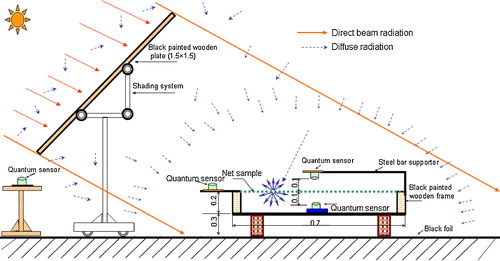
2.2.1 Clear sunny conditions
The measurements on clear sunny days were carried out on 29 and 31 December 2008; 4 January and 1, 2, 5 and 9 February 2009, i.e., one day for testing each sample. Three components of global PAR (Gp) were measured in μmol m−2 s−1: incident (GP,i), transmitted (GP,t) and reflected (GP,r). A black-painted wooden frame of 1.25 m × 2.25 m × 0.25 m was constructed (). The frame was oriented longitudinally in E-W direction and mounted horizontally 1 m above the roof of the building. Unstretched net samples were placed onto the frame, draped and fixed to the frame sides. An area of 3 m × 3 m under the frame was covered with black plastic foil to eliminate upward reflection. A horizontal bar was mounted 0.2 m above the centre of the frame () to support the inverted quantum sensor that was used for measuring the global PAR reflected upwards from the net surface. Another quantum sensor was mounted 0.15 m below the net surface for measuring the global PAR transmitted downwards from the net. The positions of 0.15 m below and 0.2 m above the net surface were optimized based on several pre-trials that were carried out before starting the actual measurements. The building (12 m height) was higher than nearby buildings and trees. Layout dimensions and positions of the quantum sensors are illustrated (not to scale) in . This design allows the specular component of the reflected PAR from the net surface to reach the inverted sensor at a range of incidence angles (θ) from 0° up to 80°. At times when θ was higher than 80°, the incident and reflected PAR were usually diffuse and the portion reflected into the hemisphere could be detected by the inverted sensor. To measure the downward global PAR above a horizontal surface, a quantum sensor was positioned a few metres away from the frame at the same level as the net surface.
2.2.2 Cloudy conditions
The measurements under simulated diffuse PAR conditions were conducted on 21, 22, 25, 26, 27, 28 and 29 January 2009, i.e., one day for each sample. For the set-up (not to scale) see . In this case the dimensions of the wooden frame were 0.7 m × 0.7 m × 0.2 m. To measure the diffuse PAR transmitted and reflected from the net sample, quantum sensors were mounted 0.1 m below and 0.1 m above the surface of the net sample, at the centre of the frame. Because the diffuse radiation transmits and reflects diffusively, the positions of the quantum sensors () did not jeopardize the accuracy of the measurements. The arrangement in was continuously shaded by moving a shading system positioned a few metres away from the frame to allow the net to receive diffuse PAR from all directions of the hemisphere. The shading system consisted of a 1.5 m × 1.5 m black-painted wooden plate, which was mounted on a structure made of black-painted steel tubes (0.0127 m in diameter). The junctions of the structure are rollers that made it possible to tilt the plate around its horizontal axis to generate enough shade to cover the frame and the sensors all day (). The following parameters were measured: the incident diffuse PAR (DP,i), transmitted through the net (DP,t), and reflected from the net surface (DP,r), all in μmol m−2 s−1.
The quantum sensors used in the two experiments were LI-190SA (LI-COR Inc.), having a time response of 10 μs with a maximum error of ±1%, a sensitivity of 5 μA per 1000 μmol m−2 s−1, a working temperature range of −40 to +65 °C, and a wavelength range of 400–700 nm. The sensors had been calibrated before use by the supplier. The measured parameters were recorded every minute, averaged over 5-min intervals, and saved in a data logger (LI-1400, 9 channels, LI-COR, Inc.).
2.3 Estimating the radiometric properties
To eliminate possible sources of error, before starting the actual measurements one-day trial runs were conducted under each weather condition, in the absence of net samples. During these tests, the PAR that reflected upwards from the floor and from the inner surfaces of the frames (offset reflection) was measured. The offset reflectance under incident global and diffuse PAR was estimated, respectively as:
Daily averages of the measured values of ρoff,g and ρoff,d were less than 0.1. So for simplicity reasons and considering that the first reflection on the panel surface instead of multiple reflections is sufficient to obtain high accuracy of solution, the former was used. Equivalent radiometric properties of the nets were estimated at 5-min intervals assuming the net as a homogeneous layer. Properties related to global PAR (i.e., global PAR transmittance (τP,g), reflectance (ρP,g) and absorptance (αP,g)) were estimated from the measured components as:(2)
(2)
(3)
(3)
(4)
(4)
Radiometric properties related to diffuse PAR (i.e., diffuse PAR transmittance (τP,d), reflectance (ρP,d), and absorptance (αP,d)) were estimated from the measured components as:(6)
(6)
By solving each couple of equations [Eqs. (Equation2(2)
(2) ), (Equation3
(3)
(3) ) and (Equation5
), (Equation6
(6)
(6) )] simultaneously using Fortran connected with IMSL mathematical library, the values of τp,g, ρp,g, τp,d and ρp,d were obtained. The total (daily integral) radiometric properties that related to global PAR (i.e., total global transmittance (TP,g), reflectance (RP,g) and absorptance (AP,g)) were estimated for clear sunny days as:
(8)
(8) where t1 and t2 are the times of sunrise and sunset, respectively. The total radiometric properties that related to diffuse PAR (i.e., total diffuse transmittance (TP,d), reflectance (RP,d) and absorptance (AP,d)) can be estimated in a similar way using Eq. (Equation8
(8)
(8) ) by replacing the symbols G and g with D and d.
3 Results and discussion
3.1 Clear sunny conditions
The time courses of the equivalent radiometric properties for the seven tested nets related to the global PAR (i.e., global transmittance (τP,g), reflectance (ρP,g) and absorptance (αP,g)) were estimated using Eqs. (Equation(2)(2)
(2) Equation(4)
(4)
(4) ) at 5-min intervals and illustrated in , respectively. PAR measured underneath the net comes from the PAR that passes directly through the net pores plus PAR that is scattered downwards from the net threads. The first is directly proportional to the net porosity (φ) and the second depends on net colour. Given the same porosity, increasing the brightness of the net, for example from dark green to green, increases the PAR transmission due to scattering. illustrates the time course of τP,g for the tested nets. A net with bright colour and low value of φ (e.g., white-50, φ = 0.28) showed the highest values of τP,g (). So due to scattering, net colour has a stronger effect on net transmittance than net porosity. Given the same colour, nets with high porosities are expected to have higher transmittances than nets with low porosities. Given nearly the same porosity, a net with interlaced flat strip texture (blue-80 net) showed a higher transmittance than a net with knitted thread texture (dark green-80 net). The changes in τP,g value with the time of the day () were similar to those of different translucent materials (e.g., plastic films, glass and rigid plastic sheets such as polycarbonate and acrylic) that were measured under natural conditions of PAR [Citation16,Citation17]. The inflection of τP,g values around the times of sunrise and sunset were mainly due to the predominance of diffuse PAR at that time, which is ascribed to a relatively high net transmittance of diffuse PAR (see (a)). According to the trends of τP,g in , it appears possible to treat the PAR transfer through a plastic net in a similar way as the transfer through homogeneous translucent material, even though the structure of the plastic net is not homogeneous.
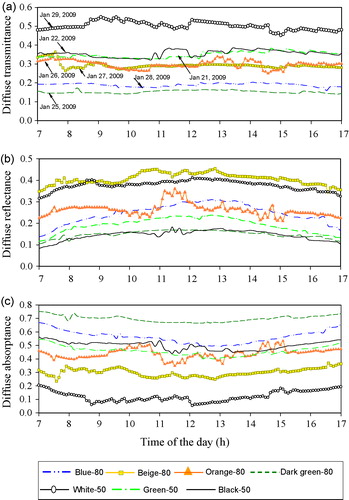

The time courses of the global PAR reflectance (ρP,g) are illustrated in for the tested nets. Net colour had a significant effect on PAR reflectance (ρP,g) much more than net porosity. Nets having bright colours (e.g., beige-80, φ = 0.12 and white-50, φ = 0.28) showed higher levels of reflectance than the other nets that had dark colours and different φ values. This is because a net with a bright colour reflects almost all the incident PAR (visible light) over the whole spectrum band of the PAR. On the other hand, a net with a dark colour reflects the incident PAR over the spectrum band of the net colour only (i.e., narrow band) and absorbs the incident PAR over the remaining spectrum of the complementary colours. It is well known that net reflectance is strictly involved in the aesthetic assessment of the agricultural structures covered with nets in the rural landscape, especially in the desert of the Arabian Peninsula region, with its high albedo. In such cases, nets with dark colours and low values of ρP,g should be chosen in order to reduce the visual impacts of the structures.

The proportion of PAR that was absorbed by the net textures is an essential parameter needed for any analysis of the PAR transfer through a net-covered structure. Therefore, the net absorptance, which is related to incident global PAR (αP,g) is an important property and should be determined for the net. shows the time course of αP,g for the nets tested. Increasing the darkness of the net together with decreasing the net porosity significantly increased the ability of the net to absorb PAR. Thus, the dark green net had the highest αP,g, whereas the white net had the lowest αP,g. also shows that the net colour had a significant effect on the value of αP,g, much more than the effect of porosity. Therefore, the bright colour of the beige net (φ = 0.12) significantly reduced the values of αP,g compared with the dark colours blue (φ = 0.21), orange (φ = 0.23) and dark green (φ = 0.20).
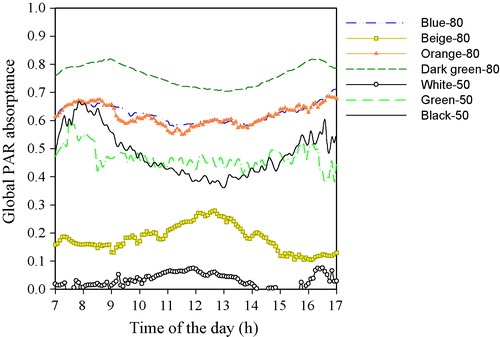
The effects of incidence angle (θ) on net transmittance (τP,g) and reflectance (ρP,g) during the period 7:00–12:00 a.m. are illustrated in and . Because of latitude and time of the year at which the measurements were carried out, the lowest values of θ were in the range from 39° to 47° at solar noon on the days of measurements. Therefore, the values of τP,g and ρP,g at low values of θ could not be represented. In and , where θ is near 90°, most of the incident PAR on the thread surfaces was reflected downwards. This, in addition to the increases in the percentage diffuse PAR at that time, slightly increased τP,g and reduced ρP,g. The trends of τP,g and ρP,g with the variation in θ are similar to those reported for translucent materials [Citation16,Citation17], especially for nets having bright colours.
Evaluating the tested nets for transmitted PAR in a winter season was one of the main objectives of the present study. The PAR transmitted through the tested nets on clear sunny winter days is presented in . Optimum PAR values (PARopt) for best growth of crops that are commonly grown in net-houses in the winter season of the Kingdom of Saudi Arabia were collected from different references [Citation18–Citation23] and transformed into W m−2. On the basis of the data in , the tested nets can be classified into 3 categories: (1) blue-80, dark green-80 and orange-80, (2) green-50 and beige-80, and (3) black-50 and white-50. lists the crops and plants that can be grown in shade houses covered with these types of nets.
Table 2 Crops and plants that can be grown in shade houses covered with the three categories of nets in relation to the PAR values required for optimum growth.
3.2 Diffuse PAR simulating cloudy conditions
Radiometric properties of the tested nets that are related to diffuse PAR (i.e., diffuse PAR transmittance (τP,d) reflectance (ρP,d) and absorptanc (αP,d) are illustrated in (a)–(c), respectively. In (a), net porosity (φ) and brightness showed positive effects on the values of τP,d. At any time of the day, nets with a high porosity showed higher values for τP,d than nets with a low porosity. Nets with bright colours (i.e., white in the nets-50; orange and beige in the nets-80) showed higher transmittances than those with dark colours (i.e., black and green in the nets-50; blue and dark-green in the nets-80). Accordingly, a net with a high porosity and bright colour is recommended to be used for covering agricultural structures under diffuse radiation of cloudy or overcast sky conditions. (b) shows that nets having bright colours (white-50 and beige-80) exhibited higher reflectance (ρP,d) than nets having dark colours. A lower net porosity slightly increases net reflectance (ρP,d) The resulting value of ρP,d depends on the combined effects of net colour and porosity. In (c), net absorptance (αP,d) increased with decreasing net porosity and increasing darkness ((c)). Thus, the dark green-80 net (dark colour, φ = 0.2) showed the highest values of αP,d, whereas the white-50 net (bright colour, φ = 0.28) showed the lowest. shows PAR transmitted through the tested nets that were mounted horizontally under simulated incident diffuse PAR on typical winter days. Under such conditions, growing crops under a structure covered with theses nets is impossible and supplementary artificial light is needed. Only vegetables such as lettuce, spinach, and indoor ornamental plants (PARopt < 30 W m−2) can be grown without the need of supplementary light. The values presented in may differ from the true values under overcast sky conditions. However, such differences are expected to be minor under the arid climatic conditions of the Arabian Peninsula region.
3.3 Total radiometric properties
The total radiometric properties (i.e., Tp,g, Tp,d, Rp,g, Rp,d, Ap,g and Ap,d) of plastic nets are often needed for any thermal analysis that includes PAR transfer through net-covered structures. The total properties are also needed to evaluate and compare different types of nets. However, data published on total radiometric properties of plastic nets often are measured in laboratories using normal incident or artificial light, and cannot therefore be considered as total properties under natural solar radiation conditions. For that reason, the total radiometric properties related to global PAR (transmittance (TP,g) reflectance (RP,g) and absorptance (AP,g) and those related to the diffuse PAR (TP,d, RP,d and AP,d) were estimated from Eq. (Equation8(8)
(8) ) using a numerical integration method [Citation24]. Values of these properties for the tested nets are illustrated in . Using this table, one can easily select the net properties that are required for a specific purpose.
Table 3 The total radiometric properties of the nets tested.
4 Conclusions and recommendations
In this study, a simple method was presented and used to measure the radiometric properties of plastic shading nets under natural conditions of global and simulated diffuse PAR. These properties are characterizing the whole net as a semi-transparent material and are not used for the net textures or threads (i.e., equivalent properties). In general, under global or incident diffuse PAR, the net transmittance and absorptance were affected by net colour and net porosity. Net colour had a predominant effect on the transmittance and absorptance values. Net reflectance was affected mainly by net colour. Major part of the transmitted and reflected PAR originated from the scattering on the net texture. Even though plastic nets are not homogeneous layers, the trends of the net radiometric properties with time were similar to those of homogeneous translucent materials (such as plastic films, rigid plastic sheets, and glass). Accordingly, it is possible to treat a plastic net as a translucent material with equivalent optical parameters (refractive index and absorption coefficient). This can help to predict the radiometric properties of a plastic net without the need for measuring. Further research is needed to develop a physical model that describes solar radiation transfer through a plastic net in order to evaluate the scattered radiation on the net threads and to provide better understanding of this phenomenon.
Acknowledgements
This work was financially supported by the Agricultural Research Centre, College of Food and Agricultural Sciences at King Saud University. The authors wish to thank Mr. M.R. Shady for his technical assistance with the experiments.
Notes
1 See Appendix A for the variables and their descriptions used in this paper.
References
- S.CastellanoG.M.ScarasciaG.RussoD.BriassoulisA.MistriotisS.HemmingD.WaaijenbergPlastic nets in agriculture: a general review of types and applicationsAppl. Eng. Agric.242008799808
- A.M.MedanyM.K.HassaneinA.A.FaragEffect of black and white nets as alternative covers in sweet pepper production under greenhouses in EgyptActa Hortic.8072009121126
- S. Hemming, G.L.A.M. Swinkels, S. Castellano, G. Russo, G.M. Scarascia, Numerical model to estimate the radiometric performance of net covered structures (AGRONETS), Paper presented at AgEng2008 Agricultural and Biosystems Engineering for a Sustainable World, Crete, 23–25 June, 2008.
- D.BriassoulisA.MistriotisD.EleftherakisMechanical behaviour and properties of Agricultural nets. Part II: Analysis of the performance of the main categories of agricultural netsPolym. Test.202007970984
- J.NijskensJ.DeltourS.CoutisseA.NisenRadiation transfer through covering materials, solar and thermal screens of greenhousesAgric. Forest Meteorol.351985229242
- S.CohenM.FuchsMeasuring and predicting radiometric properties of refractive shade nets and thermal screensJ. Agric. Eng. Res.731999245255
- G.PapadakisD.BriassoulisG.M.ScaraciaG.VoxP.FeuilloleyJ.A.StoffersRadiometric and thermal properties of, and testing methods for, greenhouse covering materials, Review paperJ. Agric. Eng. Res.772000738
- F.KloseH.J.TantauTest of insect screens. Measurements and evaluation of the air permeability and light transmissionEur. J. Hortic. Sci.692004235243
- P.SoniV.M.SalokheH.J.TantauEffect of screen mesh size on vertical temperature distribution in naturally ventilated tropical greenhousesBiosyst. Eng.922005469482
- S.CastellanoS.HemmingG.RussoThe influence of color on radiometric performances of agricultural netsActa Hortic.8012008227236
- C.KittasN.RigakisN.KatsoulasT.BartzanasInfluence of shading screens on microclimate, growth and productivity of tomatoActa Hortic.807200997102
- C.SicaP.PicunoSpectro-radiometrical characterization of plastic nets for protected cultivationActa Hortic.8012008245252
- S.CastellanoA.CanduraG.M.ScarasciaRelationship between solidity ratio, colour and shading effect of agricultural netsActa Hortic.8012008253258
- S.CastellanoG.RussoG.M.ScarasciaThe influence of construction parameters on radiometric performances of agricultural netsActa Hortic.7182006283290
- Adobe Photoshop 7.0, Adobe Systems Corporation (http://www.adobe.com/).
- L.HeT.H.ShortX.YangSolar radiation transmittance of a double-walled acrylic pellet insulated greenhouseTrans. ASAE34199125592563
- A.M.Abdel-GhanyT.KozaiC.ChunEvaluation of selected greenhouse covers for use in regions with a hot climateJpn. J. Trop. Agric.452001242250
- J.W. Mastalerz, in: A.M. Tawajen (Trans.), The Greenhouse Environment, Arabic ed., Faculty of Agriculture, Al-Basra University, Iraq, 1985.
- A.A.HassanPrincipals of Vegetables Production and Technology of the Protected Cultivations1988Arabic House for Publishing and distributingCairo
- S.H.WittwerS.HonmaGreenhouse Tomatoes, Lettuce, and Cucumbers1979Michigan Univ. PressEast Lansing
- N.YamadaY.MurataB.OsadaJ.IyamaPhotosynthesis of rice plantProc. Crop Sci. Soc. Jpn.241956246252
- F.TeiA.ScaifeD.P.AikmanGrowth of lettuce, onion, and red beet: 1. Growth analysis, light interception, and radiation use efficiencyAnn. Bot.781996633643
- C.A.P.L.AlvesA.C.N.MagalhaesP.R.BarjaThe phenomenon of photoinhibition of photosynthesis and its importance in reforestationBot. Rev.682002193208
- E.KreyszigAdvanced Engineering Mathematics6th ed.1986John Wiley & Sons Inc.New York
